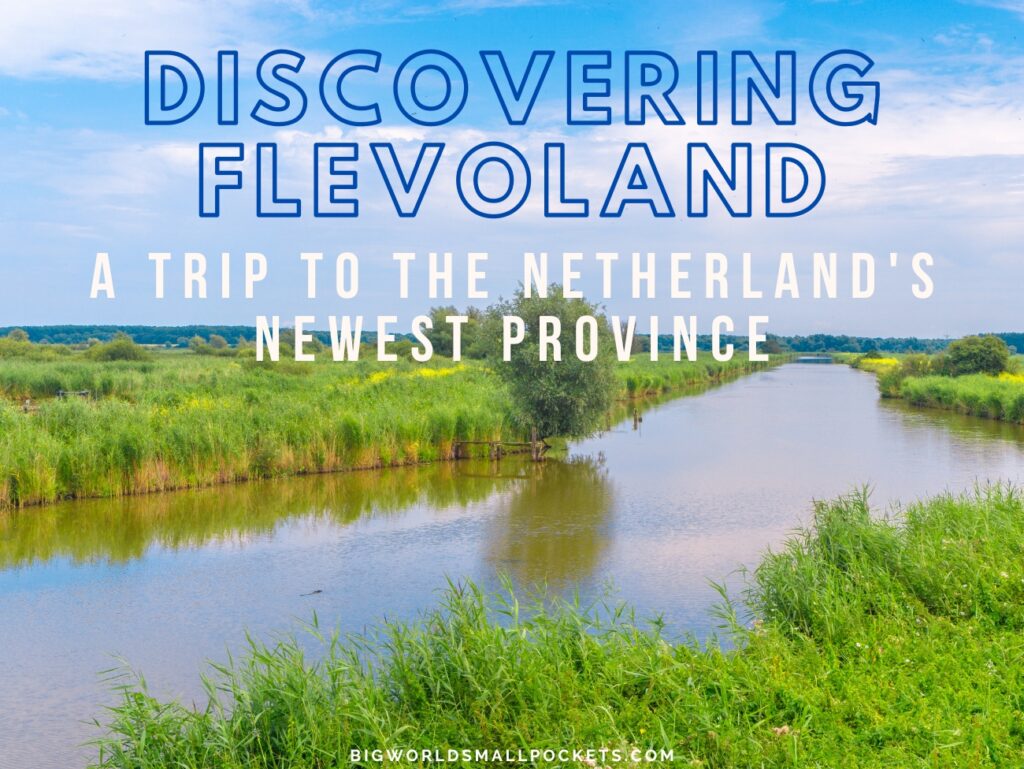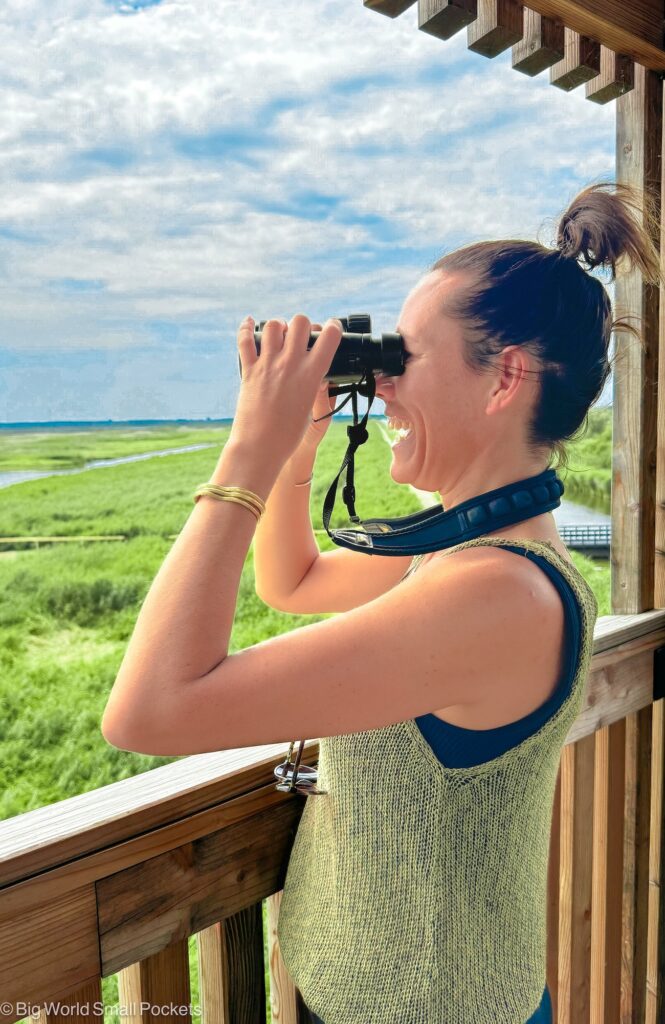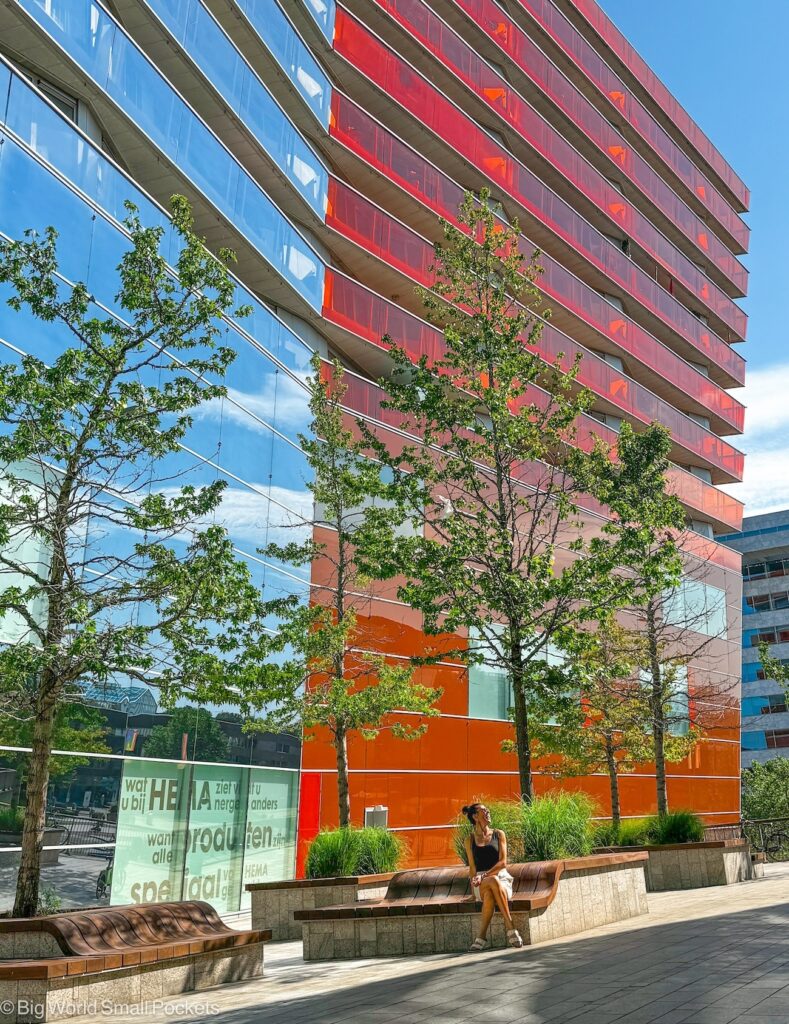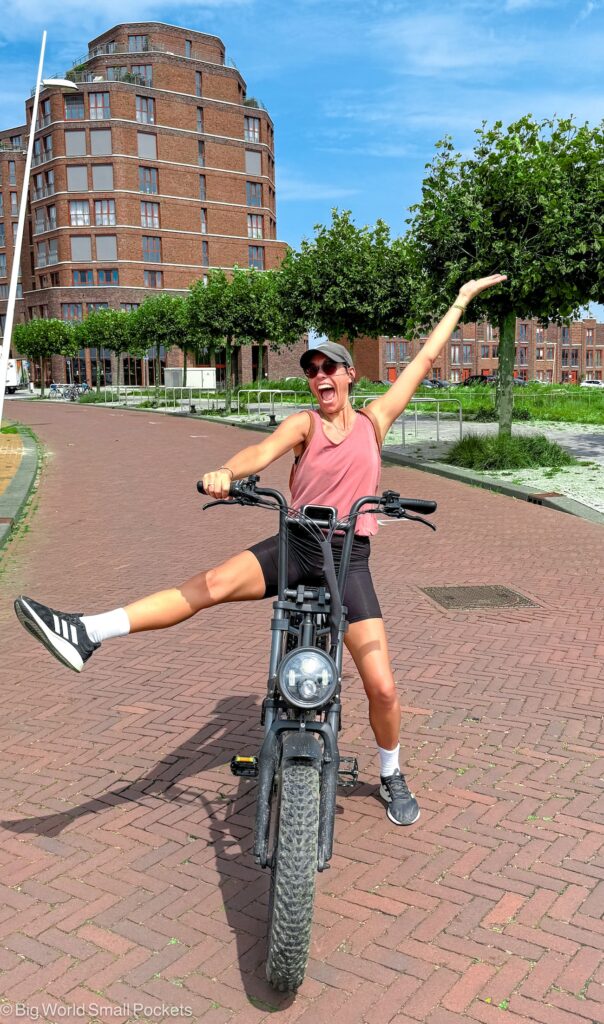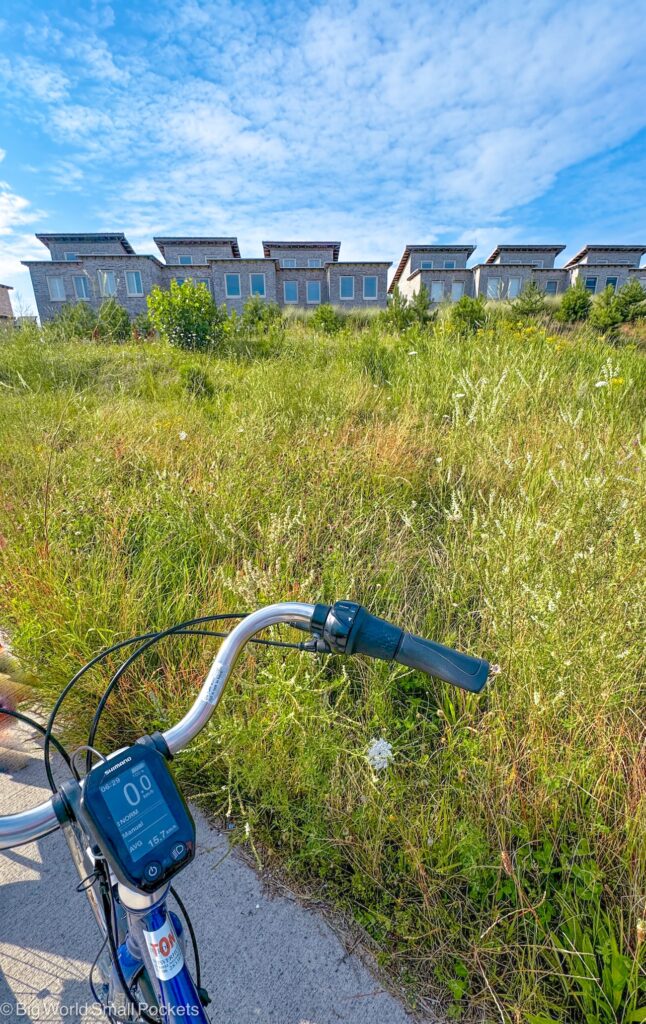Almere is the youngest and greenest city in the Netherlands and it instantly shows.
As soon as I step off the train at the station (which takes me no more than 25 mins direct from Amsterdam Centraal), I find myself in a city that instantly feels like it has been perfectly designed for 21st century living.
Clean, compact, open, airy and filled with green spaces, Almere barely feels like how we expect a large city to feel; instead it feels like an experiment, a trial in how we can build, bloom and belong better.
Modern angular architectural styles, which seem to jut out from every corner (and which bring design students from across the globe to Almere), are complimented by an enveloping softness of more natural elements – the living grass roof tops, the ripples of the lakeshore, the curved pedestrian criss-crossing paths.
Indeed sustainability is built into the very heart of Almere, with everything from insulation and energy, innovative waste removal to keeping the city naturally cool in our warming world, factored in here.
Trees proliferate, natural light pours in, and there’s tons of accessible community spaces, from family paddling spots to water sport activities on the huge manmade lake.
The playhouse on this watery edge was designed inline with feng shui principles, the library boast cafes, work stations and board game events alongside books, and high street shops rub shoulder with local independent market traders.
It’s hard to believe that when Almere was first built, according to our local tour guide, people didn’t want to live here!
Now of course, less than 50 years from when Almere was established, it’s a thriving part of the Netherlands – within easy reach of Amsterdam and filled with the sort of aspirational aesthetics that only places far from the act of ageing can boast.
Which is why exactly I’ve found myself here…
Related Posts
- Complete Travel Guide to Zandvoort: Amsterdam’s Best Beach
- Amsterdam Noord: The Hipster District You’ve Never Heard Of
- Exploring Zaandam: The Fab Alternative to the Dutch Capital
A most welcome respite from the crowds and chaos of Amsterdam in the summer; for a July weekend break, Almere makes the perfect alternative.
And of course, it’s far more affordable too.
I’m staying in the comfortable Leonardo Hotel Almere, which is right by the lake’s edge.
Within easy walking distance from both the city’s main train station and its central plaza filled with inviting restaurants, shops and cafes (including Nul36, where a delicious salad lunch is my choice), the Leonardo Hotel’s quiet, quirky building suits me down to the ground and, even better, there’s a craft brewery next door!
After an amazing alfresco dinner at the veggie-friendly Indo Kitchen Bar (another of Almere’s top dining picks) and too full to sleep, I walk along the lake’s edge, under the full of moon, and it feels both safe and serene – 2 things I don’t think I’d be uttering if I’d opted for central Amsterdam in the summer instead!
When you live in busy London, there are just certain things I want from a trip away.
One of them is peace, the other is ease.
Wonderfully I’ve caught the Eurostar from St Pancras (less than half an hour from my home) directly to Amsterdam Centraal.
Whilst onboard, I booked the convenient Sprinter train (via ns.nl/en) that runs direct from this station to Almere Centrum.
The connection time is 10 mins, which means I’ve made the whole journey in less than an afternoon.
Now I can choose to explore the canal-lined capital if I want (it’s close enough after all), or I can head in the other direction, to exploring more of Almere’s surrounding spaces during the sprawling sunny, summer days I have ahead.
I opt, of course, for the latter.
Situated 45m below sea level, Almere is found in Flevoland, the Netherlands newest province, created by some ingenious engineering technology.
Technically, it’s what I’ve come to learn the Dutch call a polder, with water from the sea still being pumped out even today.
Reclaimed from the waves around 80 years ago, there’s still many expansive green parts of the region, preserved from development, as the importance of natural spaces and the positive impact they can have on our lives is increasingly valued.
I decide to begin my adventure in the eco expanses of Nieuw Lands National Park.
One of the Netherland’s premier birdwatching spots, this beautiful area of meadow and marshland is also home to 300 wild Konic horses, 500 red deer and 300 Heck Bovine.
Some 7350 hectares big, Nieuw Lands National Park was officially declared a national reserve in 1989 and is open to the public with free walking trails and bird hides populating its outer areas.
Beyond this, an inner restricted area is home to the majority of the park’s larger mammals and safety is assured by only allowing guided safari tours to enter.
Of course, hearing the word safari my ears prick up, and so it’s not long before I’m bouncing along in the back of a converted 4wd with my excellent female park guide in the front seat, filling my ears with facts, figures and stories.
I always fear that after the splendour of the Serengeti or the mighty Masai Mara, I might have ruined my experience of safaris in other countries, but I’m delighted to say that it’s still very possible for me to get excited about a white tailed Eagle!
Lunch is served in the lovely onsite café and it’s the perfect sandwich sojourn, washed down with the quintessential glass of Dutch milk that I was looking for!
Freshly fuelled, I then head to Flevoland’s other main city, Lelystad, opting for the classic Dutch, 2-wheeled method of transport.
What would a trip to the Netherland be without some bike time after all?
In keeping with Flevoland’s modern aesthetic, this is of course, an eBike and cruising along the traffic-free trails of Flevoland in the July sunshine makes for the perfect experience.
Forget the trams and tourist-littered bike lanes of Amsterdam, this is peaceful cruising at its best, along a route filled with greenery, as a gentle breeze lightens the hot mid-afternoon sun.
My first stop in Lelystad is Batavia Stad, with its promise of some excellently-priced retail therapy.
Opened 2001, this was the first discount outlet built in the Netherlands and is home to a wave of international brands.
If you’re coming straight from the capital, it’s good to know Amsterdam South station has a direct train and bus route here that takes just 45 mins.
If you’re arriving on 2 wheels (comme-moi), then the outlet also boasts 4 tourist cycling routes in close proximity, including the land art trail that takes in the famous Gormley piece I spy across the water.
After grabbing a new swimsuit from Calvin Klein at a bargain price, I take to the outlet’s Ferris Wheel to grab the view from the air.
Across the harbour I spot the hull of a huge wooden ship – proof that even in the Netherland’s newest region I can still get my history fix!
I decide to explore it and make a beeline for Batavia Land and the New Lands Museum.
The story of this watery region’s evolving relationship with the sea, which laps at Flevoland’s 42km of coastline, unfurls through a series of fantastic interactive displays, plenty of which are family-friendly (think the ‘work your own polder’ waterpark), before I head on to see the piece de resistance – a life-size replica of the famous ship Batavia.
Initially built in 1628 and bound for Java in Indonesia, this ship’s original story ends in a unfortunate mutiny off the coast of Western Australia.
Having lived in this part of the antipodean world for a year, it feels great to be drawing the lines of history together as I take in the giant duplicate of this ship, which was painstakingly rebuilt between 1985-1995 by visionary William Fox.
Looking for a home, the new Batavia it found its way to Flevoland, where she is being lovingly restored and repaired by a team of enthusiastic marine architects.
A “social monument” for the area – the modern reconstruction of this famous Dutch wooden water vessel nestles perfectly into Leylstad’s landscape, where the sea and the land have rubbed graceful shoulders for centuries.
Eric, the information specialist at Batavia Land, leads me around; it’s amazing to be able to board this ship and even enter her submarine decks to discover the secrets of the high seas she has stored in her bowels.
With the afternoon wearing on and a golden hour glow beginning to light the sky, I then head to the final destination on my Flevoland itinerary.
Duin is another architectural gem.
A highly-desirable residential area, backed by sand dunes and a manmade lake, it has a distinctly coastal feel to it.
Cycling around in the height of summer, I have to do everything in my power not to abandon the itinerary and jump into the water from the sandy shores with the rest of the locals.
Managing to refrain, I instead listen to the fascinating local guide, who brings to life the vision of this eco-sensitive modern town as we make our way to its theatrical fringes.
Because Duin is also home to one of the Netherland’s most unique performance companies.
Living in east London, I’m used to the quirky industrial feel of a good theatre troupe, but here in Flevoland, I’m a little surprised to encounter the bohemian, dockyard setting of Vis-a-Vis.
Checking myself to make sure I’m not in Hackney Wick, I’m led past deep red shipping containers, surrounded by small wooden bridges and reeds, to enter the main space that feels like something belonging to a big-top spectacle.
There’s a carbon neutral restaurant here of course, where I enjoy a delicious vegetarian feast inspired by the flavours of Suriname, and a ramshackle-artistic bar where I grab a locally-brewed beer.
Everywhere recycled benches and up-cycled tables scatter the cute alfresco environment, as people gather to eat, chat and relax in the evening sun.
The show, I’ve been warned, will be watched by 800 spectators and is quite the impressive performance!
Running from June to September each year, the larger-than-life creations of Vis-a-Vis, a company of just 12 full-time members, are continually sold out.
Known for their mind-blowing pyrotechnics and dazzling dramatic sets, these full-throttle spectacles are loved by locals across the Amsterdam area.
Engaged and enthralled, I watch the almost 2 hour long SILO 8 without understanding a word, yet simultaneously comprehending everything.
A social commentary on how we care, or rather don’t, for our aging population, the performance is portrayed with such visual pizazz and endearing humour, that it’s impossible not to be swept along by the emotive story.
2 actors seemingly row through the sky, as a huge, transparent boat rises from a watery lake before being thrust seamlessly into the air by an enormous crane.
Industrial towers go up in flames, trap doors magically appear in the floor and huge speakers whirl from the top of pink shipping containers, while actors engage in quad bike races around the auditorium.
But if you’re thinking this might simply be gaudy showmanship, you couldn’t be more wrong!
Instead, Vis-a-Vis take us on a poignant human journey, leading us through a heart-warming tale that reflects our inevitable aging back at us.
In the incredibly contemporary environment of Duin, and Flevoland more broadly, the irony is not lost on me.
It seems that in these fresh places, we are being gifted the creative space to hear valuable new narratives; the young and the old melting and blending together in a way that has seen Flevoland rise from the sea and shine.
Just enter your details below and I'll email it you - simple!
Information will be sent to the email provided above
Mini Flevoland Travel Guide
When to Visit?
A great year round destination, I still think the best time to visit Flevoland is during the summer months.
How to Travel There?
I love taking the Eurostar from London to Amsterdam – direct in just 4 hours.
Otherwise, you can fly direct into Amsterdam Schiphol airport from hundreds of cities around the world.
Find the best rates on Skyscanner.
From Amsterdam, it’s then just short direct train journey to Almere – bookable through the national Dutch Railway website.
Where to Stay to Flevoland?
The Leonardo Hotel Almere City Centre gets my vote.
How Long to Stay?
I recommend a stay of at least 2-3 nights in Flevoland – there’s so much to see and do here!
Travel Insurance
World Nomads offers simple and flexible travel insurance. Buy at home or while travelling and claim online from anywhere in the world.
Alternatively, if you’re a long-term traveller, digital nomad or frequent remote worker seeking travel health cover, check out Safetywing’s Nomad Insurance policies.
eSIM
Avoid expensive roaming fees and grab a eSIM for your trip to the Netherlands.
I recommend Holafly.
You can get 5% off their packages with my exclusive discount code: BIGWORLDSMALLPOCKETS
Travel Money
The Dutch currency is the Euro.
Wise is the easy way to spend abroad with real exchange rates, no markups and no sneaky ATM fees.
You can use your Wise card just like a debit card and it links easily with Google and Apple pay – sold!
Grab yours here.
PIN IT TO PINTEREST!
My trip to Flevoland was sponsored by Amsterdam&Partners but, as always, all views are my own.
This page contains affiliate links meaning Big World Small Pockets may receive a small commission on any purchases at no extra cost to you.

